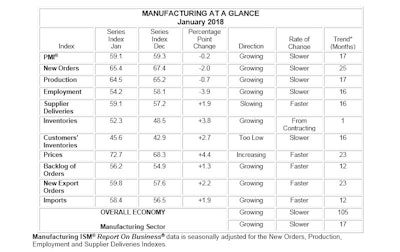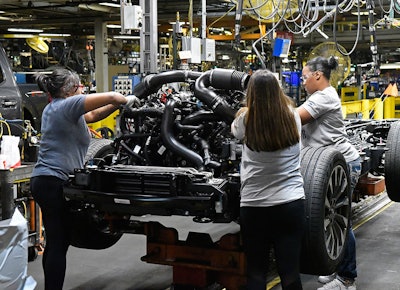
Economic activity in the manufacturing sector expanded in January, and the overall economy grew for the 105th consecutive month, say the nation’s supply executives in the latest Manufacturing ISM Report On Business.
U.S. manufacturing expanded in January as the PMI registered 59.1 percent, a decrease of 0.2 percentage point from the seasonally adjusted December reading of 59.3 percent. This indicates growth in manufacturing for the 17th consecutive month at strong levels led by continued expansion in new order and production activity, with employment growing at a slower rate and supplier deliveries continuing to struggle. A reading above 50 percent indicates that the manufacturing economy is generally expanding; below 50 percent indicates that it is generally contracting.

Timothy R. Fiore, CPSM, C.P.M., Chair of the Institute for Supply Management (ISM) Manufacturing Business Survey Committee states, “The past relationship between the PMI and the overall economy indicates that the average PMI for January (59.1 percent) corresponds to a 4.9 percent increase in real gross domestic product (GDP) on an annualized basis.”
A PMI above 43.2 percent, over a period of time, generally indicates an expansion of the overall economy. Therefore, the January PMI indicates growth for the 105th consecutive month in the overall economy and the 17th straight month of growth in the manufacturing sector.
Orders, Production and Inventory
ISM’s New Orders Index registered 65.4 percent in January, which is a decrease of 2 percentage points when compared to the 67.4 percent reported for December, indicating growth in new orders for the 25th consecutive month.
“New Orders expansion continues at a strong pace, with the index at nine straight months at 60 percent or above,” says Fiore. A New Orders Index above 52.4 percent, over time, is generally consistent with an increase in the Census Bureau’s series on manufacturing orders (in constant 2000 dollars).
ISM’s Production Index registered 64.5 percent in January, which is a decrease of 0.7 percentage point when compared to the 65.2 percent reported for December, indicating growth in production for the 17th consecutive month.
“Production expansion continues, but due to employment and supplier delivery constraints, it could not keep up with new order input and customer inventory needs, resulting in higher backlogs,” says Fiore. An index above 51.5 percent, over time, is generally consistent with an increase in the Federal Reserve Board’s Industrial Production figures.
ISM’s Backlog of Orders Index registered 56.2 percent in January, an increase of 1.3 percentage points when compared to the 54.9 percent reported for December, indicating growth in order backlogs for the 12th consecutive month. Of the 89 percent of respondents who reported their backlog of orders, 28 percent reported greater backlogs, 15 percent reported smaller backlogs, and 57 percent reported no change from December.
The Inventories Index registered 52.3 percent in January, which is an increase of 3.8 percentage points when compared to the 48.5 percent reported for December, indicating raw materials inventories grew in January.
“Suppliers made progress in responding to production demand increases by expanding their customers inventory levels,” adds Fiore. An Inventories Index greater than 43 percent, over time, is generally consistent with expansion in the Bureau of Economic Analysis (BEA) figures on overall manufacturing inventories (in chained 2000 dollars).
 In this Friday, Oct. 27, 2017, photo, workers assemble Ford trucks at the Ford Kentucky Truck Plant, in Louisville, Ky. On Thursday, Feb. 1, 2018, the Institute for Supply Management, a trade group of purchasing managers, issues its index of manufacturing activity for January. (AP Photo/Timothy D. Easley)
In this Friday, Oct. 27, 2017, photo, workers assemble Ford trucks at the Ford Kentucky Truck Plant, in Louisville, Ky. On Thursday, Feb. 1, 2018, the Institute for Supply Management, a trade group of purchasing managers, issues its index of manufacturing activity for January. (AP Photo/Timothy D. Easley)Exports, Imports and Prices
ISM’s New Export Orders Index registered 59.8 percent in January, an increase of 2.2 percentage points when compared to the 57.6 percent reported for December, indicating growth in new export orders for the 23rd consecutive month. Exports achieved their highest expansion since April 2011, when the index reached 63.8 percent.
ISM’s Imports Index registered 58.4 percent in January, an increase of 1.9 percentage points when compared to the 56.5 percent reported for December, indicating that imports grew in January for the 12th consecutive month. Import expansion reached its highest level since April 2014, when the index reached the same level, 58.4 percent. “Imports expanded at noticeably greater rates during the period in order to keep pace with production demand,” says Fiore.
The ISM Prices Index registered 72.7 percent in January, an increase of 4.4 percentage points from the December level of 68.3 percent, indicating an increase in raw materials prices for the 23rd consecutive month. In January, 47 percent of respondents reported paying higher prices, 1 percent reported paying lower prices, and 52 percent of supply executives reported paying the same prices as in December. The Price index is at its highest level since May 2011, when it registered 77.9 percent.
“The Business Survey Committee noted price increases continue in metals (steel, stainless, brass, aluminum, copper and scrap), intermediate chemicals, corrugate, crude oil, natural gas, various wood based products and plastic resins. There was a significant increase in items short, during the period,” says Fiore.
A Prices Index above 52.4 percent, over time, is generally consistent with an increase in the Bureau of Labor Statistics (BLS) Producer Price Index for Intermediate Materials.
Employment
ISM’s Employment Index registered 54.2 percent in January, a decrease of 3.9 percentage points when compared to the December reading of 58.1 percent. This indicates growth in employment in January for the 16th consecutive month.
“Employment expansion remains strong, but difficulties across the supply chain continue to constrain production output,” concludes Fiore.
An Employment Index above 50.8 percent, over time, is generally consistent with an increase in the Bureau of Labor Statistics (BLS) data on manufacturing employment.
The monthly Manufacturing ISM Report on Business is based on the survey results of approximately 350 professionals across 18 different industry sectors. The report is released on the first business day of each month and features the PMI Index as its key measure. For more information on the Institute for Supply Management, visit www.ism.ws.






















